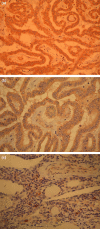Vascular endothelial growth factor (VEGF), VEGF receptors expression and microvascular density in benign and malignant thyroid diseases
- PMID: 17696908
- PMCID: PMC2517322
- DOI: 10.1111/j.1365-2613.2007.00533.x
Vascular endothelial growth factor (VEGF), VEGF receptors expression and microvascular density in benign and malignant thyroid diseases
Abstract
Angiogenesis is critical for the growth and metastatic spread of tumours. Vascular endothelial growth factor (VEGF) is the most potent inducer of neovasculature, and its increased expression has been related to a worse clinical outcome in many diseases. The purpose of this study was to evaluate the relation between VEGF, its receptors (VEGFR-1 and VEGFR-2) and microvessel density (MVD) in thyroid diseases. Immunostaining for VEGF and VEGF receptors was performed in 66 specimens of thyroid tissue, comprising 17 multinodular goitre (MNG), 14 Graves' disease, 10 follicular adenoma, 8 Hashimoto's thyroiditis, 7 papillary carcinoma and 10 normal thyroid specimens. Thyrocyte positivity for VEGF and VEGF receptors was scored 0-3. Immunohistochemistry for CD31, and CD34 on the same sections was performed to evaluate MVD. Immunohistochemical staining of VEGF in thyrocytes was positive in 92% of all the thyroid tissues studied. Using an immunostaining intensity cut off of 2, increased thyrocyte staining was seen in follicular adenoma specimens, MNG and normal thyroids compared with Hashimoto's thyroiditis and Graves' disease (P < 0.05). Similarly, VEGF thyrocyte expression in Graves' disease was less than other pathologies (P < 0.05). VEGFR-1 expression and the average MVD score did not differ between the different thyroid pathologies. VEGF expression was lower in autoimmune pathologies compared to autonomous growth processes. Conversely, both VEGFR-1 and VEGFR-2 were widely expressed in benign and neoplastic thyroid disease, suggesting that the up-regulation of VEGF and not its receptors occurs as tissue becomes autonomous. There was no clear relationship between MVD measurement and thyroid pathology.
Figures

Similar articles
-
Angiogenesis and lymphangiogenesis in thyroid proliferative lesions: relationship to type and tumour behaviour.Endocr Relat Cancer. 2006 Sep;13(3):931-44. doi: 10.1677/erc.1.01210. Endocr Relat Cancer. 2006. PMID: 16954441
-
Differential expression of VEGF ligands and receptors in prostate cancer.Prostate. 2013 May;73(6):563-72. doi: 10.1002/pros.22596. Epub 2012 Oct 4. Prostate. 2013. PMID: 23038639
-
Expression of vascular endothelial growth factor (VEGF) and VEGF receptor-1 (Flt-1) in Graves disease possibly correlated with increased vascular density.Hum Pathol. 2001 Jan;32(1):10-7. doi: 10.1053/hupa.2001.21139. Hum Pathol. 2001. PMID: 11172289
-
[Advances in study of vascular endothelial growth factor and thyroid disease].Sheng Wu Yi Xue Gong Cheng Xue Za Zhi. 2012 Aug;29(4):784-7. Sheng Wu Yi Xue Gong Cheng Xue Za Zhi. 2012. PMID: 23016436 Review. Chinese.
-
Angiogenesis in the thyroid gland.J Endocrinol. 2000 Sep;166(3):475-80. doi: 10.1677/joe.0.1660475. J Endocrinol. 2000. PMID: 11029748 Review.
Cited by
-
Prognostic and Therapeutic Role of Angiogenic Microenvironment in Thyroid Cancer.Cancers (Basel). 2021 Jun 3;13(11):2775. doi: 10.3390/cancers13112775. Cancers (Basel). 2021. PMID: 34204889 Free PMC article. Review.
-
Molecular target based combinational therapeutic approaches in thyroid cancer.J Transl Med. 2012 May 1;10:81. doi: 10.1186/1479-5876-10-81. J Transl Med. 2012. PMID: 22548798 Free PMC article.
-
Evaluation of thyroid cancer in Chinese females with breast cancer by vascular endothelial growth factor (VEGF), microvessel density, and contrast-enhanced ultrasound (CEUS).Tumour Biol. 2014 Jul;35(7):6521-9. doi: 10.1007/s13277-014-1868-2. Epub 2014 Apr 1. Tumour Biol. 2014. PMID: 24687553
-
Relationship between expression of vascular endothelial growth factor and cervical lymph node metastasis in papillary thyroid cancer: A meta-analysis.J Huazhong Univ Sci Technolog Med Sci. 2017 Oct;37(5):661-666. doi: 10.1007/s11596-017-1786-9. Epub 2017 Oct 20. J Huazhong Univ Sci Technolog Med Sci. 2017. PMID: 29058277
-
Tyrosine kinase inhibitors induced thyroid dysfunction: a review of its incidence, pathophysiology, clinical relevance, and treatment.Biomed Res Int. 2013;2013:725410. doi: 10.1155/2013/725410. Epub 2013 Oct 27. Biomed Res Int. 2013. PMID: 24282820 Free PMC article. Review.
References
-
- Akslen LA, Livolsi VA. Increased angiogenesis in papillary thyroid carcinoma but lack of prognostic importance. Hum. Pathol. 2000;31:439–442. - PubMed
-
- Anan K, Morisaki T, Katano M, et al. Vascular endothelial growth factor and platelet-derived growth factor are potential angiogenic and metastatic factors in human breast cancer. Surgery. 1996;119:333–339. - PubMed
-
- Bochner BH, Cote RJ, Weidner N, et al. Angiogenesis in bladder cancer: relationship between microvessel density and tumor prognosis. J. Natl. Cancer Inst. 1995;87:1603–1612. - PubMed
-
- Brekken RA, Thorpe PE. Vascular endothelial growth factor and vascular targeting of solid tumors. Anticancer Res. 2001;21:4221–4229. - PubMed
MeSH terms
Substances
LinkOut - more resources
Full Text Sources
Medical

